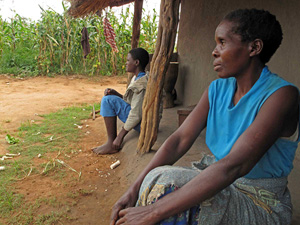
Ten years ago Joyce Mhoni, head of the Nutrition Rehabilitation Unit at Ekwendeni Hospital in the Mzimba district of northern Malawi, would have been caring for up to 30 severely malnourished children at a time. Today, at the peak of the usually lean months between December and April, when farmers are waiting to harvest, the unit is empty, and in the whole of 2010 only 15 children were admitted, mostly from outside the hospital’s catchment area.
Mhoni credits the change to a room on the other side of the hospital, where a sign on the door reads, “Agricultural Office”. The connection between malnutrition and farming practices was made in 2000, when hospital staff, together with a Canadian researcher, interviewed the parents of children admitted to the nutrition unit.
They found that most of them were only growing maize on their small plots of land, and their children were eating little besides nsima – the local name for maize-meal porridge. Years of growing just one crop had also left the soil depleted and in need of more fertilizer than they could afford.
“We wanted a programme that would address food insecurity, malnutrition in under-fives, and soil fertility,” said Lizzie Shumba, project coordinator of the Soils, Food and Healthy Communities (SFHC) project, which started as a pilot scheme working with 83 farmers in 2000.
Drawing on research by agronomists, nutritionists and development experts, the project’s staff taught farmers how to grow different varieties of legumes such as soy beans, peanuts, and peas. They were encouraged to grow a deep-rooted variety of legume, such as pigeon pea, in the same field as a shallow-rooted variety like soy bean, a method known as inter-cropping.
Soy bean is high-yielding and a nutritious food source, while pigeon pea produces a large amount of leaves that can be dug into the soil to make an effective natural fertilizer. Having only one field to weed and maintain instead of two also reduces labour.
Changing lives
Enoch Chipetupetu joined the project in 2002. As chief of his village he had more land than most, but could only afford to grow maize on about half of it because of the high cost of fertilizer. He started tentatively by planting one or two varieties of legumes and had to wait two or three years before he started seeing results.
After planting a mixture of pigeon pea and soy bean one year, he found he could grow a bumper crop of maize in the same field the following year, using little or no fertilizer.
Simply changing how and what he farmed has profoundly affected the lives of Chipetupetu and his family. He has doubled the land he cultivates, and grows enough to feed his family and sell the surplus.
The extra income has allowed the family to replace their old mud and thatch home with a larger, brick one, and pay the school fees of his six children. It has also completely changed their diet.
“Before, it was nsima, nsima, nsima,” Chipetupetu told IRIN. His wife had been advised by staff at the hospital to feed her children a healthier mixture of foods, but she had no idea how to prepare them.
Project staff started holding “recipe days” to teach participants how to turn the legumes into tasty meals and his wife now passes on seeds and recipes to her neighbours and relatives.
For others, joining the project has meant making it through the year without going hungry. Lyness Mhlanga, a widow who lives with her 12-year-old son and elderly mother on one hectare of land, started growing legumes in 2007.
Previously, she had struggled to grow enough maize to feed her children, and her son had become so malnourished that he had to be hospitalized. “Most of the time, I didn’t have money to buy fertilizer,” she said.
 Photo: Kristy Siegfried/IRIN  |
| Enoch Chipetupetu with one of his fields inter-cropped with pigeon pea and groundnuts |
A national government programme that distributes subsidized fertilizer to needy farmers only provided Mhlanga with one or two 50kg bags a year, and this year she had to share one bag with a neighbour.
A successful maize crop requires about eight bags of fertilizer per hectare, at a cost of nearly 6,000 kwacha (US$39) per unsubsidized bag – a significant amount for a poor farmer.
Now, using the techniques the project taught her, such as incorporating crop residue into the soil, Mhlanga can get by with only one or two bags of fertilizer. With no one to help her in the fields, she cannot grow a surplus to sell, but harvests enough to ensure her family stays healthy.
Keys to success
Word has spread and every year more farmers ask to join the project. To be selected, “farmers have to have shown interest, be very food insecure, and we also target the HIV-affected households,” said Shumba.
The project now has 7,000 participants and has been able to add about 500 more every year because a seed multiplication programme distributes legume seeds to new farmers, who are then expected to return twice the quantity of seed when they harvest.
The selection and training of new farmers, as well as seed distribution and data collection, are all done by a group of volunteer farmers who make up the Farmer Research Team. “I think the project has been a success because of them,” said Shumba.
To expand the number of participants and lift them above subsistence, the farmers need to find markets for crops that are unfamiliar to most Malawians. “[They] think to be satisfied, they need to eat a big bowl of nsima and some relish,” said Mhoni of the Nutrition Rehabilitation Unit.
Shumba said some farmers had formed an association to search for markets for their legumes but they were struggling to find buyers. “They’re just selling locally to vendors for a low price,” she said.
At a recent annual Field Day, some project participants showed other farmers their fields and explained the inter-cropping method. Later they were invited to taste coffee made from roasted ground soy beans, fried soy meat, and bean fritters.
Joubert Soko, one of the farmers invited to the event, said it was the first time he had tried such foods. “Normally I eat nsima or rice; it’s really boring,” he told IRIN.
Soko said about three-quarters of the farmers in his community were already inter-cropping with legumes and he was keen to join them. “We still have malnutrition, but it’s going down because people in our area are trying this.”
EKWENDENI, 8 April 2011 (IRIN)
[This report does not necessarily reflect the views of the United Nations]

.jpeg&w=60&q=100&h=60)




.jpeg&w=60&q=100&h=60)





